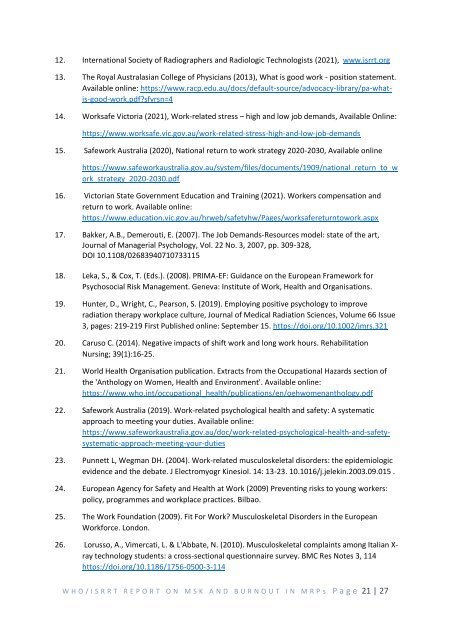Health_and_safety_of_Radiographers_and_WHO_MSK_Burnout_paper
You also want an ePaper? Increase the reach of your titles
YUMPU automatically turns print PDFs into web optimized ePapers that Google loves.
was relatively small, it does provide an insight into the outcomes <strong>of</strong> working clinically in the<br />
healthcare industry for even a short period <strong>of</strong> time. With 91% <strong>of</strong> respondents expressing moderate<br />
to high exhaustion <strong>and</strong> 79% expressing moderate to high disengagement, this is cause for some<br />
consideration. Data from respondents reporting neck <strong>and</strong> lower back discomfort in this study, have<br />
also been identified by Kumar et al 27 who highlighted a significant range <strong>of</strong> musculoskeletal<br />
problems in x-ray technologists.<br />
RECOMMENDATIONS<br />
It is recommended that medical radiation workplaces strongly consider the long-term effects <strong>of</strong><br />
occupational hazards on their workforce <strong>and</strong> engage with their staff to reduce the risks <strong>of</strong><br />
musculoskeletal injuries <strong>and</strong> staff burnout. Workplace <strong>safety</strong> is a dual responsibility for both<br />
employees <strong>and</strong> management. The suggestions below may be a starting point for conversation.<br />
Clinicians<br />
<br />
<br />
<br />
<br />
Identification <strong>and</strong> reporting to management <strong>of</strong> physical hazards.<br />
Regular training <strong>and</strong> education in preventative measures including debriefing sessions when<br />
required.<br />
Recognising when well-being assistance is required.<br />
Implementation <strong>of</strong> a self-care routine which may include healthy eating habits, exercise,<br />
mindfulness, <strong>and</strong> meditation practice.<br />
Management<br />
<br />
<br />
<br />
<br />
Consideration from management to identify <strong>and</strong> implement improvements in design or<br />
management <strong>of</strong> work to mitigate both psychosocial <strong>and</strong> physical hazards. The process <strong>of</strong><br />
continuous monitoring <strong>and</strong> data collation to ensure the <strong>safety</strong> <strong>and</strong> well being <strong>of</strong> staff is<br />
paramount.<br />
Consultation with staff in relation to improving the ergonomics <strong>of</strong> the workplace e with an<br />
action plan on how to reduce the potential for both initial musculoskeletal injury <strong>and</strong><br />
subsequent aggravation <strong>of</strong> existing or past injuries.<br />
Any changes in work practices will need to be effectively communicated with staff.<br />
Resource provision for staff well-being incorporating strategies for coping with workload,<br />
stress <strong>and</strong> exhaustion.<br />
W H O / I S R R T R E P O R T O N M S K A N D B U R N O U T I N M R P s P a g e 18 | 27

















